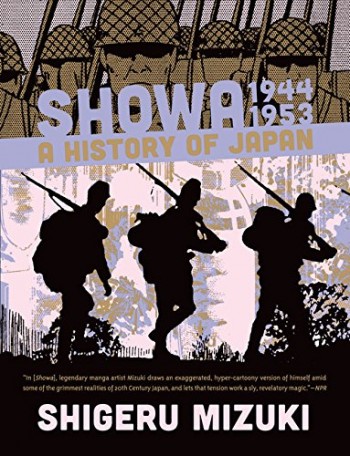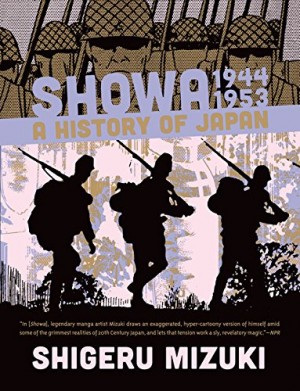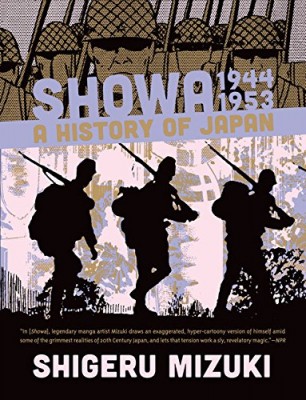
GRAPHIC NOVEL REVIEW: Showa: 1944-1952: A History of Japan, Vol. 3
KEEP CALM and SURVIVE! Shigeru Mizuki, one of Japan’s greatest artists and one of the pioneers in manga, continues searching, reflecting, and making sense of his country’s past in the third part of his Showa saga, Showa: 1944-1952: A History of Japan, Vol. 3. Similar to the first two volumes, the third part clocks at […]
KEEP CALM and SURVIVE!
Shigeru Mizuki, one of Japan’s greatest artists and one of the pioneers in manga, continues searching, reflecting, and making sense of his country’s past in the third part of his Showa saga, Showa: 1944-1952: A History of Japan, Vol. 3. Similar to the first two volumes, the third part clocks at 550 pages, with notes at the end of the story that highlighted some important information regarding the personalities, events and cultural practices involved in this majestic but balanced view of Japan’s tumultuous history.
CHECK OUT… GRAPHIC NOVEL REVIEW: Showa 1939-1944: A History of Japan, Vol. 2
Again, this volume serves as the author’s semi-autobiography and political-social-cultural history. Mizuki recounted his first-hand experiences from the twilight of the Second World War, Japan’s humiliating surrender, up to the United States’ occupation from 1945 up to 1952. On the other hand, his other image, “Rat Man”, guides readers in different places and times where the author was not personally present during those times. In those moments, Shigeru relied on extensive readings of both scholarly and primary sources on the topics involved; in addition of the character’s frequent breaking the fourth-wall moments that add flavor and humor to this very serious visual literature. The artist applied montages that came from historical photographs which he carefully crafted to maintain the sense of historical accuracy as if animation and real events go hand-and-hand, and with greater effects in sequential narration.
The readers see Shigeru’s experiences as a reluctant soldier under dire circumstances during the tail-end of the Second World War in his stationed position in the Southern Pacific region, including his failed attempts to escape his post, his encounters with various inhabitants, near death situations due to malaria attacks, how his left arm was cut-off, and how he endured and witnessed how his Japanese military superiors imposed “military justice” to their subordinates. We also glimpsed how the artist’s family coped to the hardships and anxiety brought by the war, especially during the Allied bombardments on Japan from 1944 to 1945. And most significantly, Shigeru presented readers how the Japanese society really struggled, particularly the common folks, in the final years of World War Two and the first years of American Occupation after that. We witness how they resorted to various means to get around the rationing policies and other strict laws imposed upon them in the face of humiliation from Japan’s defeat. And, he presented a different view regarding Douglas MacArthur’s rule on Japan, especially on making Japan “democratic”, “modern” and most importantly, a significant “ally” during the Cold War. Moreover, we witness how Mizuki survived the war in the most inconvenient and luckiest ways possible, including his brand of resilience and physiologically endowed amongst his peers then. All delivered with his brand of humor and knack of being awkward (or eccentric) in the midst of bombings, hopelessness, and desperations in the final months of the war and the post-war eras. Readers may remind his uncanny ways of survival in the character of Art Spiegelman’s father in “Maus”. Please be reminded that he balanced what are historical facts from sheer propaganda from the Imperial Japan and MacArthur-ruled administrations (in classic or Rankean form of historiography, doubting “official” records of the government or seats of power). And, the artist provided insights rarely seen from any serious history books of the Second World War and Japan, like some tales of hubris among top echelons of the Japanese government, most notably on premier Hideki Tojo and other ultranationalist military leaders in power, and military commanders who were caught between fulfilling their duties for subjects of Emperor Hirohito and being realistic on fighting the lost cause (read: the shame-honor culture). Clearly, Shigeru delivers his anti-war message to the readers, particularly to younger generations whose perception on war and its connections are anything but “abstraction”.
Similarly to the last volume, this visual literature has several mentions of the Philippines, and even devoted a chapter about the historical decisive naval battle of all—The Battle of Leyte Gulf. I admire Shigeru for making no excuses that the Japanese imperial mouthpiece/propaganda—The Greater East Asia Co-Prosperity Sphere—was nothing but the deliberate act of showing Japanese authority and power over its colonies, including the Philippines. Indeed, Japan did “grant” the Philippines its “independence” on 1943, though it was just, well, propaganda at best. Furthermore, the artist made a “what if” historical scenario in the said naval battle that possibly could have favored the Japanese in either prolonging the war or more incredibly, turned the favors on Japan once again. Gladly, Mizuki stopped on exploring those possibilities and accepted the fact that after the battle in Leyte, Japan was on the losing end already.
Despite the impressive displays of honesty and balance on the part of Shigeru, there are still some minor historical omissions and mistakes to be highlighted here. First, he did mention his fears of being attacked by “alligators”. Obviously, the most common species in the Pacific and Asia regions are crocodiles, particularly the salt-water types (actually, there are a number of cases that there were crocodile attacks on trapped Japanese troops in the swampy areas of Southeast Asia). Second, Yamashita Tomoyuki, the last top Japanese military leader in the Philippines, was executed in the province of Laguna, not Manila as what the notes showed. Of course, the existence of “kamikaze” or suicide pilot bombers was mentioned and showed action in the Leyte Gulf encounter. However, it would be appropriate if the writer explored further why and how young pilots were recruited and convinced to do their ultimate sacrifices, and not mentioning specifically where “kamikaze” was born (in Mabalacat, Pampanga). In connection with the battle, Shigeru failed to know that the American forces obtained valuable information regarding the exact coordinates in executing the Operation Sho-Go through the help of the guerrilla forces in Cebu. Historically, the Philippines was arguably the most hostile place the Japanese forces encountered, most particularly with their dealings with several guerilla forces scattered around the archipelago, and their numerous maltreatments with civilians alike. Despite numerous efforts by the Japanese to show that they were the true liberators, not the Americans, the Filipinos/as simply didn’t buy that wholeheartedly. There were numerous cases of political collaborations, indeed, but majority people in the Philippines held on the promise of General MacArthur’s promise of return, and even clandestinely supporting guerrilla efforts through espionage and reconnaissance missions on important and strategic Japanese posts. Moreover, Shigeru did mention the “Battle of Luzon” but stopped there instead of highlighting several intense battles between the American and Filipino forces and the Japanese troops, especially in Manila itself. So intense that Manila was regarded the second most devastated city in the whole world after Warsaw, Poland during the war. Not only the destruction of numerous properties and buildings but confirmed reports of atrocities committed by the Japanese troops that later laid upon to Yamashita in the war trial in 1944-1945. Moreover, why there were no mentions of the infamous Unit 731, Japanese doctors who conducted gruesome human experiments in China in the 1930s up to the early 1940s? Does Mizuki hear of this or if so, does not acknowledge its existence at all? And, the artist mentioned that Pres. Harry S. Truman suggested the use of nuclear weapons in defeating the North Koreans and Chinese during the height of the Korean War in the early 1950s. Actually, it was General MacArthur who suggested that one (he really hated to lose. He once said quoted that “there is no substitute for victory”). President Truman relieved MacArthur due to the latter’s insistence of continuing the war and wanting authorization of using those devastating bombs, despite threats from its former ally and bitter rival, the Soviet Union.
Overall, the third volume of the Showa saga proves an invaluable piece of historical evidence from the eyes of one of the most revered and distinguished artists in Japan. Shigeru is honest in showing the follies his fellow Japanese commanders and leaders during and after the Second World War. He knows the prevailing atmosphere of denying or sanitizing many of Japanese atrocities committed, but he instead shows a brave face by acknowledging majority of these brutalities, to the point of apologizing for Japan’s wartime actions. Balancing what really happened in and out Japan and the dominating acts of either distorting or propagating “facts” that either favored the ruling powers or saccharine the unpleasant events, the artist rather chooses the former and putting these into historical context to humanize what were the (possible or real) forces or motivations that drove the leaders and the societies involved. Of course, he lacked some historical knowledge about the Philippine experience during the war except the most “historically significant” moments that were printed in many textbooks histories, but the bottom line here is that he never said that the Japanese rule in the Philippines was either wholeheartedly accepted by the people or simply “a good one”. Despite the thickness of the book, it is very accessible, readable and enjoyable, and it simply shows how Shigeru is still at top of his game even though he is already past his prime. He is currently doing (or finishing?) the last Showa chapter, from 1952-1989. Hopefully, he can finish that one sooner than later.














